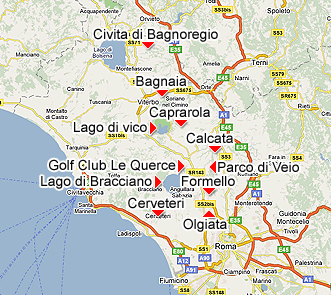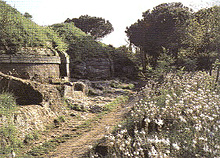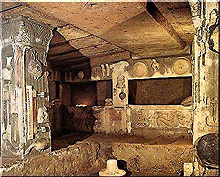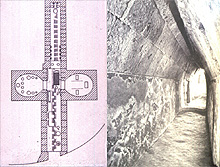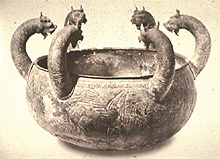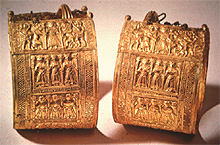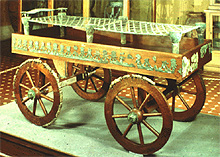| Cerveteri The Etruscan Tombs at Cerveteri
A Brief History of the Site "The ancient city (Cisra for the Etruscans, Agylia for the Greeks and for the Greeks) famous for its maritime trading, occupied an immense area protected by steep slopes and fortifications. Situated only a few miles from the coast, access to the sea was ensured by three ports: Pyrgi, Alsium and Punicum. From the 7th century BC onwards, Caere underwent lively development, becoming Etruriaís port for the Orient. Gold jewellery and vases are of particularly fine workmanship; the craft of bucchero ware was also born here in this period. In the 6th century BC, Caere, at the height of its power, clashed, emerging victorious, with the Greeks of Italy who at the time were establishing their control on the Tyrrhenian Sea. Commercial relations were not interrupted but, on the contrary, a rich community of merchants and craftsmen of Greek origin flourished in the city. After the crisis common to the whole of Etruria in the 5th century BC, there was a strong recovery in the next century, made possible in part thanks to the excellent relations enjoyed with Rome, of which Caere was a traditional ally. This policy was abandoned at the beginning of the 3rd century BC, when the city rebelled against the interference of Roman power; defeated, it lost part of its territory,including the coastal area. Deprived of its ports, Caere was thus doomed to a crisis which came to an end with its total extinction in the 1st century AD." (From The Etruscans)
This is a photograph of the interior of the Tomb of the Bas-relieves, Banditaccia Necropolis, and appears to date from about the seventh-century B.C. The tombs of the Etruscans were architecturally constructed to resemble their homes, and this is no exception. However, the tombs at Caere have no frescoed walls, as is the case with its southern neighbor Tarquinia. Instead, the walls are carved with heavy relief depicting many different everyday objects, and that is distinguishing feature of this photo. "A variety of different elements come together in the composition of this vase, made of the finest bucchero from Cerveteri, and with incised decoration. The ancient tradition, taken up in the Italo-Geometric pottery of forming handles or the knobs of lids in the shape of animals here is allied with the Geometric tradition of the askos, an animal skin made into a water container and modeled as a quadruped or a bird. This is a fresh interpretation of a type of tall jug with a transverse, cask-like body. A long vertical neck... ending in a trefoil spout rises from the body, which is placed on a support of purely ceramic derivation. The elaborate plumes on the perforated spouts in the shape of animal heads are certainly 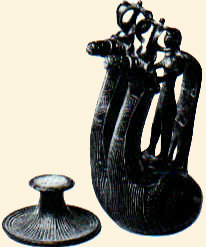 oriental
in tradition, and serve a stoppers for the two halves into which
the vase is separated, inside and out. The human figure on the body
of the vase, who holds in his extended hands the horses' harness,
as well as the circular ornament on the side of the vase suggest
the idea of a fantastic chariot whose body is fused with that of
the two horses." (From Museo
Gregoriano Etrusco II) oriental
in tradition, and serve a stoppers for the two halves into which
the vase is separated, inside and out. The human figure on the body
of the vase, who holds in his extended hands the horses' harness,
as well as the circular ornament on the side of the vase suggest
the idea of a fantastic chariot whose body is fused with that of
the two horses." (From Museo
Gregoriano Etrusco II)This late seventh-century vase, from the Calabresi tomb in the Sorbo necropolis, is an example of the bucchero-ware that developed in Caere in the seventh-century B.C. Bucchero is a style of shiny black ceramic pottery made from the natural bucchero clay of the region, and is generally discovered solely in Etruria. It is the most common type of Etruscan-made pottery, and appears to have had a wide variety of uses in Etruscan society. As noted in the above commentary, this vase is done in the Orientalizing style, although bucchero-ware evolved later on to reflect the Archaic advancement in art, as did Etruscan art as a whole. "Amphora of Exekias - This amphora came to Etruria from the Athenian workshop of Exekias, the greatest potter working around 530 B.C. Depicted on the principal side of this amphora, are Achilles and Ajax... who, having cast aside their arms, play "morra". On the other side, Kyllaros, the horse 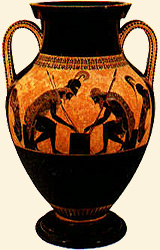 tamed
by Kastor, dominates the scene. Behind is Kastor, welcomed by Leda
and Tyndaros and his brother Pollux. Exekias carried the black-figure
technique to perfection, particularly in the way he created intense
contrasts." (From Museo
Gregoriano Etrusco I) tamed
by Kastor, dominates the scene. Behind is Kastor, welcomed by Leda
and Tyndaros and his brother Pollux. Exekias carried the black-figure
technique to perfection, particularly in the way he created intense
contrasts." (From Museo
Gregoriano Etrusco I)This amphora is typical of the pottery which the Etruscans obtained through their expansive trade with Greece and Magna Graecia. The study of Greek pottery owes much to this trade, for a great number of pieces have been discovered in Etrurian dig sites. These pieces aid in the chronological dating of not only Greek pottery, but the history of ancient Greece as a whole. This particular piece is known to have been unearthed in Etruria, but its precise location is not mentioned, possibly illustrating a 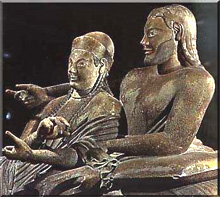 dark
chapter in archaeology: the illegal trafficking of antiquities.
This continues to plague even current archaeology, with all the
advances of the modern world at its disposal. dark
chapter in archaeology: the illegal trafficking of antiquities.
This continues to plague even current archaeology, with all the
advances of the modern world at its disposal.(From The Etruscans) This terracotta couple form the exquisite lid a sarcophagus discovered in the Bandicaccia necropolis. It was the custom of the Etruscans in Caere to decorate the lids of the sarcophagii of those who could afford it, depicted as though they were reclining on a banquet couch in the prime of life. The two statues exhibit typical Greek Archaic characteristics with their Egyptian hairstyles, almond-shaped eyes, and disproportional bodies. Due to the vast Etruscan assimilation of Greek artistic styles into their own, this sarcophagus lid is a good example of the Etruscan Archaic style in terracotta sculpture. The Regolini-Galassi Tomb
This bronze cauldron, or lebes, from the Regolini-Galassi tomb shows the intricate bronzework of the Etruscans and dates to about 650 B.C. Notice the protomes, or handle attachments, wrought into the shape of griffin-heads. Clearly of a Near-Eastern influence, they were undoubtedly created during the Orientalizing Period, as the date confirms. This piece can now be found in the Vatican Museum, Rome.
|
